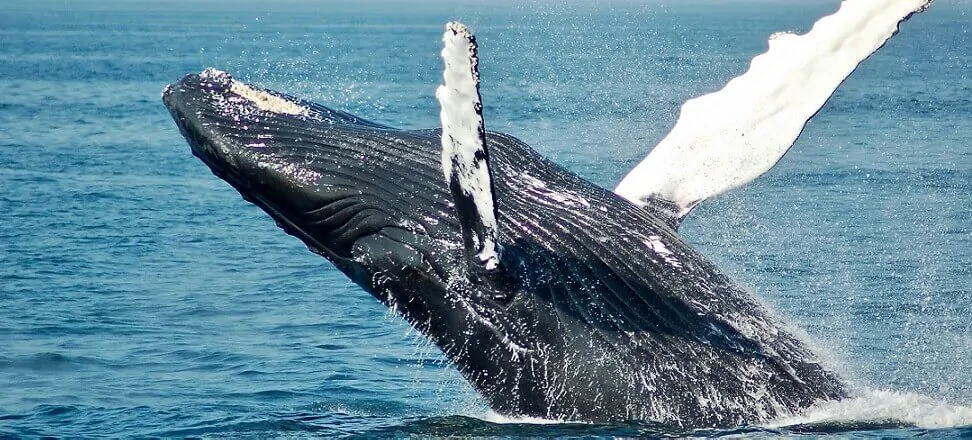Issue 14/2024, News
Whale migrations – for up to 265 days a year
Imagine a journey of 265 days, covering nearly 19,000 miles. km. This is the daily routine of humpback whales, which swim from the summer waters of Antarctica all the way to the tropical coast of Colombia before returning south. These majestic mammals traverse the waters of 28 countries and open oceans each year, making one of the longest migrations on Earth. Indefatigable in their migration between feeding zones and breeding sites, they play an important role in maintaining the health of the oceans and helping to naturally sequester carbon dioxide. Nevertheless, each such journey comes with increasing threats.
Whale migrations
Whales often follow established migratory routes, which can be determined by geographic factors such as coastal shape, ocean currents and food availability. Water temperature also plays an important role, affecting food availability and suitable conditions for reproduction. Migrations of these mammals are linked to reproduction, rearing of young and avoidance of extreme climatic conditions. Whales spend the summer months in food-rich Arctic and Antarctic waters, and in winter migrate to warmer bodies of water where, although food is less abundant, conditions are more favorable for reproduction and care of young. This seasonal migration allows them to make the most of seasonal environmental changes.
Physiological adaptations of whales to long-term migrations
Long migrations require whales to make special physiological adaptations. Their unique body structure, including their streamlined shape and powerful fins, enables them to move efficiently. In addition, their ability to dive long and deep allows them to explore deep-sea areas rich in food. Scientists have discovered that whales have the ability to efficiently store fat. The blubber, a thick layer of fat, not only plays an insulating role, but also serves as a major source of energy when the whales are on long migratory routes where access to food is limited. Blubber contains a significant amount of lipids, which are used as energy reserves. In addition, this fat helps regulate buoyancy, which is important for efficient movement in the water.
The high concentration of myoglobin in their muscles allows whales to store oxygen, which makes long dives possible. The circulatory system of these mammals is also adapted to long journeys, thanks to the presence of large amounts of hemoglobin and the ability to control blood flow, which helps conserve energy. Whales also have a highly acute sense of hearing, enabling them to detect sounds made by other individuals from up to many kilometers away. This ability is particularly important for mating and locating other whales.
In addition to physiological adaptations, whales benefit from echolocation. This ability allows marine mammals to navigate the ocean, find food and avoid potential threats even in dark and murky waters where visibility is limited. With echolocation, whales can determine the distance to objects, their speed, direction of movement and size, as well as judge whether an object is hollow or solid. Research on echolocation has shown that toothed whales, such as sperm whales and beaked whales, use this ability during deep dives, producing thousands of clicks as they search for food.
The echolocation process can be divided into search, approach and capture phases of prey. The capture phase is characterized by intense buzzes with very short intervals between clicks. Buzzes, also known as buzzes or final rasps, are a series of rapid clicks emitted by toothed birds to precisely locate and capture moving prey during the hunt.
The integration of these advanced physiological and sensory adaptations enables whales not only to survive, but also to move and forage efficiently over vast distances in dynamically changing ocean conditions.
Impact of migration on marine ecosystems
Whale migrations have a significant impact on marine ecosystems. By moving between different areas of the oceans, whales contribute to nutrient transfer. Scientists note that the presence of whales in specific regions often correlates with greater biodiversity and better ecosystem health. An example is the role they play in iron pumping, where they enrich the waters with iron through their feces, which promotes the growth of phytoplankton, the base of the ocean food chain. When whales dive deep, they bring nutrients to the surface, which supports the growth of phytoplankton, which, through photosynthesis, absorb huge amounts ofCO2 from the atmosphere. As a result, the oceans become a powerful carbon sink.
Let the whales live
Whales are among the largest and longest-lived animals on Earth. They can store large amounts of carbon in their bodies for long periods of time. Whales also efficiently digest and store large amounts of carbon-rich prey, exhaling very little carbon dioxide back into the atmosphere. One whale can capture an average of 33 tons of carbon dioxide during its lifetime. By comparison, an oak tree, one of the most efficient carbon-capturing tree species, captures approx. 12 t ofCO2 in 500 years.
Restoring whale populations to pre-whaling era levels, when they numbered between 4 and 5 million individuals – compared to just over 1.3 million today – could significantly increase the amount of phytoplankton in the oceans. Even a 1 percent increase in phytoplankton productivity due to whale activity would capture hundreds of millions of tons of additionalCO2 annually.
Despite drastic reductions in commercial whaling, whales are still exposed to serious dangers such as collisions with ships, entanglement in fishing nets, plastic pollution and underwater noise. A natural approach to carbon sequestration is an ideal solution to global warming. All we have to do is let the whales live in peace!
Photo. main: Todd Cravens/Unsplash

 Polski
Polski







